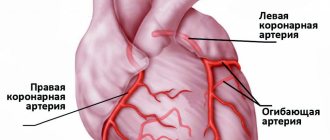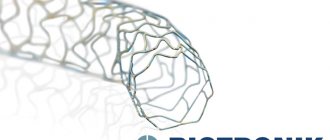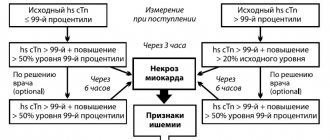Myocardial infarction
– an extremely dangerous and severe manifestation of coronary heart disease. Myocardial infarction is the death (necrosis) of a section of the heart muscle caused by a critically dangerous deterioration of blood supply in the coronary arteries. Experts note that myocardial infarction most often affects the male half of the population. If previously the conventional age of patients with myocardial infarction was 55-60 years, today cases of such pathology in young people are increasingly being recorded. The risk of death from myocardial infarction is very high. A patient with myocardial infarction requires urgent hospitalization in the intensive care unit. The life of the victim will depend on how quickly he receives the necessary treatment.
Main causes of myocardial infarction
There is a risk group - a population whose likelihood of developing myocardial infarction is higher than the rest of the population. It includes:
- men over 50 years old.
- hypertensive patients.
- smokers and alcohol abusers.
- overweight.
- persons leading a sedentary lifestyle.
- persons who have previously had a heart attack.
The main cause of myocardial infarction
It is considered to be a narrowing of the lumen of the coronary arteries caused by atherosclerotic changes. Increased blood clotting leads to the formation of blood clots that disrupt blood circulation in the heart muscle. The tissues of a vital organ suffer from a lack of nutrients. Myocardial infarction can be triggered by severe emotional and physical stress, the presence of coronary heart disease or angina, as well as diabetes, obesity, addiction to alcoholic beverages and smoking.
Clinical case
A patient was admitted to the hospital with severe chest pain that lasted for three days. Taking analgesics and Nitroglycerin did not bring relief. Previously, a diagnosis of angina pectoris FC II was made. A week before the attack, I experienced severe stress, and my condition worsened. The cardiogram revealed a large-focal infarction localized in the anterior wall, acute stage. In the blood - increased myoglobin and troponin.
After a month of hospitalization, the patient was discharged for treatment on an outpatient basis. An ECG showed scarring in the affected area, and blood counts returned to normal.
Stages of the disease and main signs of myocardial infarction
Myocardial infarction goes through several stages in its development. The duration and severity of each depends on the size of the lesion, the condition of the blood vessels, concomitant diseases and complications, as well as the correctness of the chosen treatment tactics. There are acute, subacute periods, periods of scarring and post-infarction periods. Many patients noted that the acute period was preceded by some signs of unstable heart function - angina pectoris, arrhythmia.
Acute period
can last up to 10 days. This is the most difficult time for the patient, when all sorts of complications arise and the likelihood of death is quite high. A characteristic clinical picture of the acute period of myocardial infarction is severe pain in the chest area radiating to the left shoulder, collarbone, neck, ear, and shoulder blades. The sensations of spasm can be different - cutting, stabbing, pressing, burning. This condition during myocardial infarction lasts from thirty minutes to several hours. An attack during myocardial infarction occurs in waves. The pain may increase or decrease. It is impossible to stop them with nitroglycerin. At the same time, during myocardial infarction, the patient experiences severe weakness, a feeling of lack of air, and anxiety. Pallor of the skin, cyanosis (acrocyanosis) of the nasolabial triangle, arrhythmia, and profuse sticky sweat are also noted. Possible increase in blood pressure.
Subacute period of myocardial infarction
characterized by the disappearance of pain. Their preservation indicates the addition of pericarditis (inflammation of the outer lining of the heart). Necrotic processes in the area of inflammation can cause fever with a rise in body temperature. The patient is concerned about persistent low blood pressure.
Scarring period
in case of myocardial infarction, it is characterized by gradual healing of the affected area through the formation of scars. The duration of the process ranges from several weeks to several months. The patient's condition improves significantly. Painful symptoms disappear.
Post-infarction period
– time for recovery and return to normal life. It is recommended to avoid moving heavy objects on your own, give up alcohol and smoking, follow a diet, monitor your body weight, monitor your pulse and blood pressure, and avoid prolonged exposure to the sun.
It is important to know that there are atypical forms of myocardial infarction, in which the signs of a life-threatening condition are not always obvious. They make diagnosis and timely provision of medical care difficult. Among the most common:
Sign up for a test for myocardial infarction
Make an appointment
About the disease
In the classic painful or anginal form of MI, we observe the following signs:
- severe retrosternal pain radiating to the left half of the head and arm, interscapular area;
- profuse cold sweat;
- severe anxiety, turning into fear of death;
- sudden onset of weakness and shortness of breath.
A patient who is mentally prepared for such a situation will be able to call an ambulance in time, and his correct actions in the pre-hospital period will help minimize the consequences. But when acute ischemic disorders manifest themselves differently, the patient can greatly harm himself through improper self-medication and a delayed call to the emergency room.
Complications of myocardial infarction
In the first hours of myocardial infarction, various complications may arise that aggravate the patient's condition. This is the appearance of an aortic aneurysm, myocardial rupture, cardiogenic shock, cessation of cardiac activity (asystole), pulmonary edema. The consequences of a heart attack can accompany the patient for life. These are heart rhythm disturbances, cardiosclerosis and other problems associated with disruption of the cardiovascular system. Experts do not guarantee absolute recovery after a heart attack and recommend following all the instructions of a cardiologist in order to avoid a relapse. The next attack threatens the appearance of a new area of necrosis. It is almost impossible to compensate for such consequences for the heart.
Expert advice
When the first signs of a heart attack appear, measures should be taken immediately.
I advise you to immediately call an ambulance, and while the doctor is on the way, provide the patient with complete rest, sit him down or put him in a position that will alleviate the condition as much as possible. Give Corvalol, Nitroglycerin, Aspirin, ventilate the room. The most dangerous period is the most acute period, which is usually manifested by very severe pain, shortness of breath, and rhythm disturbances. The patient’s life depends on the speed and correctness of the actions of the person nearby. When calling a doctor, it is best to describe the symptoms so that a specialized team can arrive to take an ECG, give oxygen, and administer medications to limit the area of necrosis.
Diagnosis and treatment of myocardial infarction
In addition to the clinical picture of myocardial infarction and taking a detailed medical history, a number of additional studies are used to confirm such a serious diagnosis:
If you suspect a heart attack, you must call an ambulance for urgent hospitalization in the cardiac intensive care unit. A patient with myocardial infarction is prescribed strict bed rest, rest and dietary nutrition with the exception of foods that excite the nervous and cardiovascular systems. Therapy is aimed at relieving pain, eliminating arrhythmias and heart failure, restoring normal blood circulation and combating the formation of blood clots. For this purpose, analgesics, neuroleptics, antiarrhythmic drugs, and thrombolytics are used. The list of medications is individual for each patient. It corresponds to the extent of the current disease, the general well-being of the patient and the presence of associated complications. In addition to medications, according to special instructions, surgical treatment methods are used - bypass surgery, excision of an aortic aneurysm, implantation of pacemakers (a device that sets the correct heart rhythm).
Features of symptoms
In my practice, this type of MI was more common in patients 45-50 years old. Therefore, when complaining of stomach problems in patients of this age, I recommend checking the heart.
An attack can be triggered by various reasons. If you look through the stories, you can see records of previous excessive physical activity, stress, or severe overeating during a family celebration.
The main symptoms of the abdominal form of myocardial infarction are determined by its name. They are associated with unpleasant sensations in the abdominal cavity, and not in the chest, as one might expect from cardiac dysfunction:
- pain in the epigastric region - the upper abdomen, with possible spread along the anterior wall;
- severe heartburn and belching begins;
- nausea appears, which turns into vomiting;
- The stomach is swollen due to increased flatulence.
All these dyspeptic disorders have a cardiac pathogenesis. Simply put, they appear because a blood clot occurs on the back wall of one of the ventricles or the septum between them. This leads to the appearance of a necrotic focus surrounded by a zone of stenosis - weakened blood circulation due to vasoconstriction.
But the proximity of this area to the digestive organs creates a syndrome that deceptively resembles gastroenteric disorders.
The acute stage of the attack lasts 20-60 minutes, develops in waves, gradually. If the patient is questioned more carefully, and he is able to listen to his feelings, then he should also feel pain behind the sternum and in the region of the heart.
Cost of consultation for myocardial infarction?
| Name of service | Price, rub.) |
| Initial appointment with a cardiologist | 1800 rub. |
| Repeated appointment with a cardiologist | 1300 rub. |
| Primary appointment with a general practitioner | 1800 rub. |
| Repeated appointment with a general practitioner | 1300 rub. |
| Prescription of treatment (drawing up an individual treatment regimen) | 1000 - 2500 rub. |
All our services and prices
Prevention of heart attacks
Damage to the blood vessels of the heart is much easier to prevent than to treat.
To do this you need to follow a number of simple rules:
- get rid of harmful addictions such as smoking and alcohol abuse;
- change your eating habits, choosing in favor of coarse fiber and proteins to the detriment of excess fats and carbohydrates;
- increase aerobic activity to at least 8,000 steps per day;
- monitor blood pressure daily, visit the clinic annually for medical examination and do an ECG;
- take 75 mg of Aspirin every day - but this is suitable for people with relatively healthy liver and kidneys.
Recognizing abdominal MI is a difficult task even for an experienced therapist. But the ability to quickly obtain a cardiogram and rapid tests confirming necrosis in the heart muscle greatly simplifies this problem. Where hospitals and mobile teams are provided with good equipment, mortality from atypical forms of ischemia is reduced by 20-30%.
Increases survival after acute cardiac circulatory disorders by 50-60% by knowing the patient himself about typical and atypical signs, as well as the rules of emergency self-help.
Prevention of myocardial infarction
Despite all the efforts of modern medicine, mortality from heart attacks will continue to remain quite high. To reduce the likelihood of this pathology occurring, you need to know how to prevent the disease. Expert recommendations:
Sign up for a test for myocardial infarction
Make an appointment
What treatment will the patient have?
Usually a person knows that he is developing IHD and is prepared for its acute manifestation.
In this situation, you need to follow a clear algorithm of actions:
- Call an ambulance.
- Lie down on a bed or sofa with your head elevated.
- Place one or two Nitroglycerin tablets under your tongue and dissolve them, but do not swallow.
- After 5 minutes, take two tablets of the same Nitroglycerin again.
- If the pain does not go away after 20 minutes, take aspirin, also two tablets.
It is advisable to provide access to fresh air.
In a hospital, usually in an intensive care unit, after confirmation of the diagnosis, intensive treatment begins.
It includes:
- pain relief with strong analgesics;
- protection of the heart muscle from hypoxia - oxygen starvation;
- attempts to dissolve a blood clot using special drugs, that is, to carry out thrombolysis;
- surgical intervention if necessary.
After the acute condition is relieved, there is a long stage of complex rehabilitation therapy. From my practice, I can recall many examples of successful treatment and return to active life in patients who followed all my recommendations.
Lower IM
AMI with isolated ST-segment elevation in leads II, III, and aVF is usually associated with damage to the right coronary artery (RCA) or the distal circumflex artery (CA). A rather unpleasant feature of AMI with damage to the inferior wall is that the ST segment elevation associated with the infarction can develop over a long period, up to two weeks, to become evident on the ECG [4]. The inferior wall can be supplied with blood from the right coronary artery (in 80% of cases) or from the OA, which is a branch of the left coronary artery.
ST segment elevation in lead III is greater than in lead II, and ST segment depression of more than one mm in leads I and aVL suggests damage to the RCA, which supplies the inferior wall. In the case of blood supply to the lower wall from the OA, the rise of the ST segment in lead III does not exceed the rise in lead II. In this case, either an elevation of the ST segment in aVL is observed, or it is located on the isoline [6, 7].
ECG predictors of reperfusion
Pathogenetic therapy for AMI has the goal of restoring blood flow in the affected artery. Lack of restoration of blood flow (reperfusion) is the most powerful predictor of the development of LV systolic dysfunction and the risk of death after AMI. In the absence of reperfusion, 30-day mortality can reach 15% [14]. In turn, the resolution of ST segment elevation is an indicator of improved short-term (30-day) and long-term (one-year) prognosis [5]. Assessing ST segment resolution is also useful for deciding on further management of the patient.
Failure to resolve the ST segment within the first 90-120 minutes after thrombolytic administration should be a reason to consider angioplasty. A specific marker of reperfusion that has occurred is considered to be a reduction in ST segment elevation by more than 50-70% in the lead with maximum elevation, which is associated with the most favorable further prognosis. At the same time, a number of authors propose a criterion of 50% reduction in ST segment elevation after 60 minutes of reperfusion therapy as a predictor of a good prognosis in individuals with AMI [13]. Considering that the maximum effect from subsequent angioplasty after thrombolysis is achieved no later than 6-8 hours from the onset of AMI [14], reducing the time for assessing reperfusion has good reason.
Other ECG markers of reperfusion include T wave inversion within four hours of AMI onset. T wave inversion, which occurs within the first hours of reperfusion therapy, is a highly specific sign of restoration of blood flow. T wave inversion, which develops after more than four hours, is associated with natural ECG dynamics during AMI and does not indicate restoration of blood flow. Accelerated idioventricular rhythm 60-120 beats/min, late, paired, ventricular extrasystoles are also a highly specific marker of reperfusion. These rhythms are considered not dangerous and, as a rule, do not require antiarrhythmic therapy. Polymorphic ventricular tachycardia and ventricular fibrillation can also be associated with reperfusion, but are rare and more often a consequence of persistent coronary occlusion.










